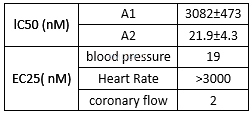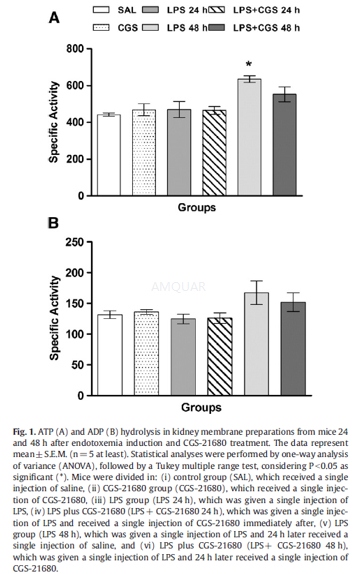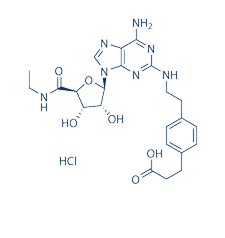-
生物活性
CGS 21680 HCL is a selective Adenosine A2A-R agonist (Ki = 27 nM). Has affinity for A1 and A3 adenosine receptors but can be used to distinguish A2A- and A2B-mediated effects.
Affinity of agonists at adenosine receptor subtypes[1]

Effects of adenosine receptors in rat brain tissue and cardiovascular function[2]

Receptor binding affinities of adenosine receptors in dog brain[3]

CGS 21680 potently stimulated the formation of CAMP with an EC50 of 110 nM.[4]
-
体外研究
-
体内研究
30% propylene glycol, 5% Tween 80, 65% D5W(5%葡萄糖水溶液)
-
激酶实验
-
细胞实验
Cells, medium and reagents[5]
Thymocytes were isolated from adult thymus ex vivo and incubated in RPMI-1640 medium supplemented with 5% dialyzed foetal calf serum (heat-inactivated), or in AIM-V serum free medium and 100 u/ ml penicillin, 100 mg/ ml streptomycin, 1mM sodium pyruvate, 1mM HEPES, non-essential amino acids, and 5x10-5M 2-mercaptoethanol. Adenosine and adenosine analogues were prepared freshly as 20 - 100mM stock solution with pH adjusted to 7.1.
Measurements of cyclic AMP
DBA-2 thymuses harvested, thymocytes isolated and resuspended at 4x106cells/ ml in the culture media (RPMI-1640) at 4oC. Incubations of cells (4x105thymocytes per assay) with various agents were performed in 1.5 ml Eppendorf tubes in a final volume 200μl containing media alone, or adenosine (0 ± 125μM), CGS 21680 (0 ± 10μM), and/or ZM 241,385 (0 ± 1μM). Controls such as the complete reaction mix at time zero or no cell mixture was used with every experimental set. The reactions were initiated by the addition of adenosine or adenosine analogues and incubation lasted from 0 ± 120min at 37oC in an Eppendorf Thermomixer Model 5436. Thymocyte reaction mixtures were gently resuspended every 5min and reactions were terminated by the addition of 25ml of 1N HCl, followed by freezing of samples on dry ice. The cyclic AMP levels were determined using cyclic AMP enzyme immunoassay (EIA) kit from Amersham according to manufacturer's instructions.
Cell incubations and extractions were performed in the absence of cyclic AMP phosphodiesterase inhibitors IBMX to avoid complications with interpretation of results due to the possibility of their effects on adenosine receptors

-
动物实验
Animals[6]
In all experiments, male F1 mice (approximately 8–10 weeks old, weighing around 50 g) were used and housed four to a cage, with water and food ad libitum. The animal house was kept on a 12 h light/dark cycle (lights on at 7:00 am) at a temperature of 23±1 °C.
Experimental protocols
The animals received intraperitoneal (i.p.) injections of saline (0.9%), LPS (12 mg/kg) and CGS-21680 (0.5 mg/kg body weight) according to the groups described below. All solutions were administered in a volume of 2μL/kg body weight. Mice were randomly divided in: (i) control group (SAL), which received a single injection of saline, (ii) CGS-21680 group (CGS-21680), which received a single injection of CGS-21680, (iii) LPS group (LPS 24 h), which was subjected to endotoxemia by a single injection of LPS, and (iv) LPS plus CGS-21680 (LPS+CGS-21680 24 h), which was subjected to endotoxemia by a single injection of LPS and received a single injection of CGS-21680 immediately after. In order to evaluate the effect of CGS-21680 when the endotoxemia had already become established, the following groups were analyzed: (v) LPS group (LPS 48 h), which was subjected to endotoxemia by a single injection of LPS and 24 h later received a single injection of saline, and (vi) LPS plus CGS-21680 (LPS+CGS-21680 48 h), which was subjected to endotoxemia by a single injection of LPS and 24 h later received a single injection of CGS-21680. All animals were euthanized by decapitation 24 h after the last injection.
Preparation of kidney membranes
about 1.0 g of both right and left kidneys was dissected on ice, washed, and gently homogenized in 10 volumes of a medium containing 0.32 M sucrose, 0.1 mM EDTA and 5.0 mM HEPES, pH 7.5 (Medium I), before being centrifuged at 1000 g for10 min. The supernatant was collected and centrifuged again at12000 g for 20 min. The resulting supernatant was discarded and the pellet was resuspended in 1.2 mL of Medium I. An aliquot of 1.0 mL of the crude mitochondrial fraction was mixed with 4.0 mL of 8.5% Percoll solution and layered onto an isoosmotic discontinuous Percoll/sucrose gradient (10%/16%). After centrifugation at 15000 g for 20 min, the fractions that banded at the 10%/16% Percoll interface were collected with a wide-tip disposable plastic transfer pipette. The kidney membrane fraction was washed twice with Medium I by centrifugation at 15000 g for 20 min to remove the contaminating Percoll. The pellet resulting from this second centrifugation was then resuspended to a final concentration of 0.5–0.8 mg/mL. The membranes were prepared fresh daily and maintained at 0–4 °C throughout the experimental procedure.
Assays of ecto-nucleoside triphosphate diphosphohydrolase(E-NTPDase) and ecto-5′-nucleotidase activities
For the measurement of ATP hydrolysis in membrane fractions, the reaction mixture employed contained 45 mM Tris–HCl, 5.0 mM KCl, 0.1 mM EDTA, 10 mM glucose, 225 mM sucrose, 1.5 mM CaCl2, 0.1 mMsodium azide, and 2.0 μg/mL oligomycin, pH 7.5, in a final volume of 200μL. The adenosine 5′-diphosphate (ADP) hydrolysis was assessed using the same reaction mixture described above, except for the fact that 1.0 mM CaCl2 was included and neither sodium azide nor oligomycin were employed in these assays. The activity of ecto-5′-nucleotidase was determined in a reaction medium containing 100 mM Tris–HCl, 1.0 mM MgSO4, pH 7.5, in a final volume of 200 μL. About 13 μg of kidney membrane protein was added to each tube and these were preincubated for 10 min at 37 °C. The enzyme reactions were started by the addition of nucleotides as substrates in afinal concentration of 1.0 mM (ATP/ADP) or 2.0 mM (AMP). After 10 min of incubation, trichloroacetic acid (TCA) (5%, final concentration) was added to stop the reactions.

-
不同实验动物依据体表面积的等效剂量转换表(数据来源于FDA指南)
|  动物 A (mg/kg) = 动物 B (mg/kg)×动物 B的Km系数/动物 A的Km系数 |
|
例如,已知某工具药用于小鼠的剂量为88 mg/kg , 则用于大鼠的剂量换算方法:将88 mg/kg 乘以小鼠的Km系数(3),再除以大鼠的Km系数(6),得到该药物用于大鼠的等效剂量44 mg/kg。
-
参考文献
[1] Klotz K-N. Adenosine receptors and their ligands. Naunyn-Schmiedeberg's Archives of Pharmacology. 2000;362(4-5):382-391.
[2] Hutchison AJ WR, Oei HH, Ghai GR, Zimmerman MB, Williams M. CGS 21 680C, an A2 Selective adenosine receptor agonist with preferential hypotensive activity. J Pharmacol Exp Ther. 1989;251(1):47-55.
分子式
C23H29N7O6.HCl |
分子量
535.98 |
CAS号
124431-80-7 |
储存方式
﹣20 ℃冷藏长期储存。冰袋运输 |
溶剂(常温)
|
DMSO
105 mg/ml |
Water
<1 mg/mL |
Ethanol
<1 mg/mL |
体内溶解度
约28 mg/mL
-
Clinical Trial Information ( data from http://clinicaltrials.gov )
注:以上所有数据均来自公开文献,并不保证对所有实验均有效,数据仅供参考。
-
相关化合物库
-
使用AMQUAR产品发表文献后请联系我们






















